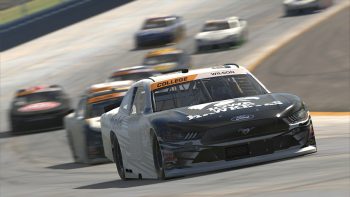
NASCAR iRacing Series Open Garage: Kentucky Speedway
June 27th, 2014 by JaimeB
One of many 1.5 mile ovals on the NiS schedule, Kentucky is no cookie-cutter.
Kentucky Speedway, for some, is one of the most difficult of the 1.5 mile speedways. You would think with its steep banks and wide front straight it would be one of everybody’s favorites; however the bumpy surface and limited preferred driving grooves can be deceiving. There are points where the rough surface, combined with windy conditions and track temperature, can cause the car to just cut loose for no apparent reason . . . or just bog down, reducing critical momentum.
Many have commented that the base setup is loose to the point of being nearly uncontrollable. Newer drivers have found themselves spinning through the front stretch. Further inspection of the base setup shows an overly aggressive camber setting in the left front and a conservative right front camber also waiting to surprise the driver by producing premature tire wear. These settings, combined with the unusual spring package, seem to be a good place to start for this week of sim racing.
Since we are dealing with bumps (and a new rules package) we are going to draw from our previous knowledge on how springs and shocks work to kill two birds with one stone. In a previous article we learned that softening the front springs will allow the car to lean forward in the turns. By adjusting the rebound we can dampen the impact of most major bumps, making the car more controllable in traffic and easier to drive overall. This also has the added benefit of sealing the car to the track surface in the turns.
Since we are still getting used to the new rules and heavier springs, we are going to use common knowledge when making adjustments to the springs. We want to dampen the impact of the bumps, reduce the bounce of the car and seal it in the turns. To achieve this we are going to take about 250 lbs out of the right front and 300 lbs out of the left front. The stagger will help the car sink-in on entry and, when combined with a small reduction in the rebound of the rear shocks, will retain some traction on exit.
To compensate for the spring adjustment making an already loose car even looser we are going to move the weight forward between 10 and 13 inches. This will tighten the mid-corner and exit without causing too much push on entry. You will want to experiment with the weight placement to get a good feel on exit. You may also want to consider adjusting the steering ratio to your preference.
To gain a bit of speed we are also going to want to reduce the ride height in the front, reducing the airflow under the car and allowing us to achieve the “seal” around the front valance we are looking for. You want to reduce the ride height equally across the front, counting the “clicks” as we discussed in a previous speedway issue.
“Find a good line and be consistent, take care of your tires and they’ll take care of you.”
Reducing the left front camber will not only help tighten the car, but will reduce the amount of uneven wear in the tires, giving us more speed over longer runs. Try reducing the camber in the left front while increasing the camber in the right front. Monitor your tire temperatures and try to find a compromise between speed, handling and wear. You may also make pressure adjustments in the tires to control temperatures.
Now that we have tightened the car and lowered its ride height, another adjustment we might want to consider is adjusting the size and preload of the “front anti-roll bar.” With the new setup rules I have found that making adjustments to the “ARB” can produce huge benefits in car stability, especially on speedways with rough surfaces.
Softening the front anti-roll bar will help the car handle the bumps a bit better, reduce the push on entry and loosen the car enough to give us some throttle control on exit.
You’ll also want to add a bit of tape to gain a little downforce and speed, but be mindful of your water and oil temperatures. Try not to overdrive the car into the turns, as I have found that this not only increases tire wear but most of the times results in slower lap times. Find a good line and be consistent, take care of your tires and they’ll take care of you . . . and you will find yourself gaining spots on long greens.
Good Luck and God Speed!
Don Scott















































